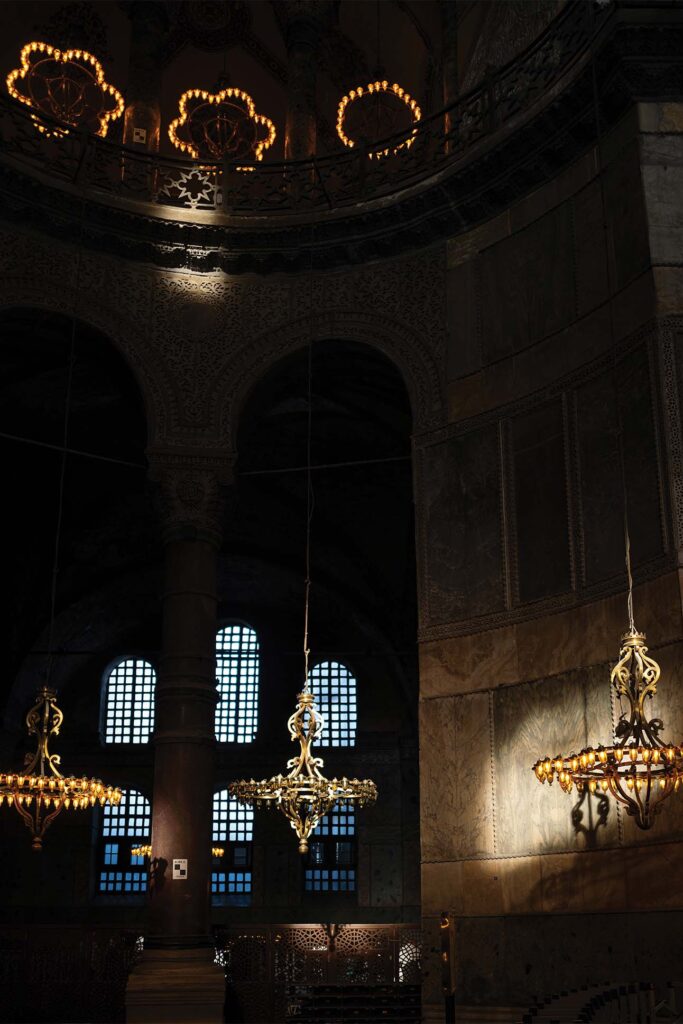Text by Martha Cheng
Images by Michelle Mishina
When given the choice, I like to arrive in a new city at night. In the darkness, the city offers itself to you in glimpses, doling out its charms in flickers of light, like a femme fatale’s entrance in a film noir. In Istanbul’s case, it was a glimpse of Taksim Square, slicked with rain, where I was initially deposited from the airport, then a wide lane lined with kebab shops, funneling into the narrow, labyrinthine streets of the hilltop Cihangir neighborhood. Before bed, a small taste of my surroundings: a meal of fat figs and tiny dumplings heaped with yogurt, seasoned with the anticipation of seeing a city that we were once thwarted from.
A few years ago, a friend and I had booked flights to Istanbul as the culmination of a month-long trip through Portugal and Morocco. But at some point during our travels, the presidents of the U.S. and Turkey had a spat, and we were denied entry into Turkey when we attempted to board our plane from Paris to Istanbul. We’ll try again someday, we reassured ourselves. But then we had our own spat and falling out. The pandemic hit shortly after, and then she had a baby. Istanbul seemed to be on hold indefinitely. And then one day it wasn’t. She was to join me in the city later that evening.

In the early hours of dawn, when the adhan called and the darkness lifted, Istanbul revealed what we missed during our nocturnal arrival: the Bosphorus Strait in the distance, a city skyline pierced with the towering, slender minarets of Ottoman mosques. It was then we realized our plans extended no further than simply getting to Istanbul.
I’m embarrassed to admit that we didn’t see all the requisite sights. We lined up for the Hagia Sophia and briefly joined the hordes at the Grand Bazaar, but we mostly wandered the city’s streets, poking into modern boutiques and vintage shops, and spent hours in the luxury of uninterrupted conversation over expansive Turkish breakfasts, at baklava emporiums, at meyhanes where the servers apologized for tables that were available for “only” two hours. We fell into a stupor of post-pampered bliss at Cağaloğlu Hamam, one of the city’s most resplendent Turkish baths, built in 1741, where bathing attendants had guided us by the hand to a heated marble slab, lathered us in olive-oil soap, and washed our hair with linden shampoo. We relished the time capsule of 1924 Istanbul, a Russian restaurant established by émigrés that fled the Bolshevik revolution, dining on ice-cold lemon-infused vodka and beef stroganoff in an opulent room paneled with dark wood and mirrors.



A friend who has lived in Turkey for eight years shepherded us through her favorite places in Istanbul: Sehzade Erzurum Cag Kebabi, a kebab shop where skewered lamb is draped with lavash as diaphanous as a silk handkerchief, and Lezzet i Şark, which offers cheese-stuffed knafeh drenched in sugar syrup and prepared over coals. She took us on a ferry to the city’s Asian side, to Kadıköy market, before we escaped the rain into Wayana wine bar to sample Turkish wines made from native grapes. And then, with little room in our stomachs, we headed to Çiya Sofrasi, an unassuming restaurant where the proprietor—a past feature on Netflix’s Chef’s Table—is considered more of a culinary anthropologist than a chef for his efforts to preserve recipes in danger of disappearing. A counter filled with more than a dozen warm pots and trays offered up dishes like lamb stewed with quince and pomegranate juice, and stuffed sheep intestine, and, for dessert, crisp slices of candied pumpkin.
It is hard for me to make sense of my brief time in Istanbul—but perhaps with just a week, it is only possible to see the city in glimpses. It is, after all, a city spread across two continents; of a population almost twice that of New York City at 15 million people, more than a third of whom are migrants; and with a history that stretches back to the Byzantine era—the very origin of the term byzantine—but has seen rapid Westernization.


In this city, I saw men walk around with pinpricks of blood dotted across their scalps from hair transplants, and in a corner of an open-air market where pet food and pet pigeons are sold, I observed a woman haggle with a vendor for leeches to treat her ailments. There were the famously spoiled stray cats of Istanbul, napping on top of stacks of records, warming themselves on the seat of a motorbike, crowding outside of a pet store, waiting to be fed. There was the Museum of Innocence, which Turkey’s famous writer Orhan Pamuk conceived in concert with his novel of the same name—each exhibit corresponding with a chapter in the book. Before the entrance is Pamuk’s museum manifesto, attesting that “the ordinary, everyday stories of individuals are richer, more humane, and much more joyful” than “historical narratives of a society.”

And maybe this is why I don’t feel so guilty for eschewing the monuments for long conversations with my friend in quotidian spaces, for picking up where we left off in our travels and lives much altered. There was only one landmark that we spent hours with—the Bosphorus Strait. The public ferry took us along its path to the Black Sea, languorously passing historical mosques and palaces. The water had a way of calming the frenzy of the city, reminding us that it has outlasted all of the buildings, the empires that erected them, the lives within and those yet to come.





